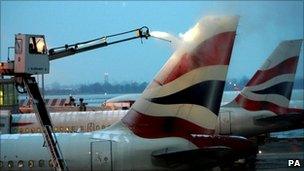How do you de-ice a plane?
- Published

Planes may freeze again 20 minutes after being sprayed
Airport staff are battling freezing conditions to get snow-hit aircraft off the ground. So how do you defrost a Jumbo Jet?
To passengers stranded in Britain's snow-hit air terminals, it might sound like yet another source of delays and frustrations.
But removing and preventing the build-up of ice on the wings and fuselage of an aircraft is absolutely crucial to preventing accidents, says David Learmount, operations and safety editor of Flight Global.
The ice changes the shape and texture of the wings and their flaps, he says, creating a drag effect and making the aircraft impossible to control. "If there's too much ice, you leave the runway with not enough lift to get airborne."
Because salt is corrosive to a plane's aluminium frames, he says, de-icing chemicals such as glycol are sprayed on its body before takeoff.
Glycol works like antifreeze in a car, reducing the freezing point of water to as low as minus 50C.
It is usually applied through high-pressure jets at temperatures as warm as 65C. And, says Mr Learmount, it will normally contain a coloured dye so that staff applying it can see they have not left any part of the plane out.
Special vehicles with a nozzle on the end of a hydraulic cab are used to reach all parts of the aircraft.
Usually a precautionary anti-icer solution - which helps prevent the build-up of ice - is applied after the de-icer.
However, in very low temperatures, this may have little impact.
Jamie Bowden, an aviation analyst and former BA customer services manager, says the "hold-over time" between a plane being sprayed and it needing to take off before it freezes again can be as low as 20 minutes.
"They have to be de-iced relatively close to the take-off point," he says. "You can't just do it early in the morning if you're flying in the afternoon."
In a busy terminal like Heathrow, he adds, with a limited amount of de-icing equipment and hundreds of flights needing to be co-ordinated, this can create a logistical nightmare.
"I know from years of working in terminals that when the weather does change, you have no option but to shut the place down," he adds.
Although there are many reasons why airports close in this weather, such disruption is a source of irritation for passengers. But history suggests that it is better to be safe than sorry.
In January 1982, Air Florida Flight 90 crashed into a bridge shortly after take-off from Washington National Airport in Washington DC, killing 74 people.
An investigation found that ice and snow had been sucked into the engines.
It also concluded that de-icing procedures had not been properly followed.